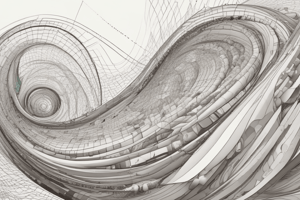Podcast
Questions and Answers
What does the derivative of a function f at a point x=a represent?
What does the derivative of a function f at a point x=a represent?
- The minimum value of the function
- The rate of change of the function with respect to x at that point (correct)
- The maximum value of the function
- The average rate of change of the function
What is the main purpose of implicit differentiation?
What is the main purpose of implicit differentiation?
- To find the maximum value of an implicitly defined function
- To find the minimum value of an implicitly defined function
- To find the derivative of an implicitly defined function (correct)
- To find the derivative of an explicitly defined function
In which field is the derivative used to model real-world phenomena, such as velocity and acceleration?
In which field is the derivative used to model real-world phenomena, such as velocity and acceleration?
- Physics (correct)
- Optimization
- Computer Science
- Economics
What is used in implicit differentiation to find the derivative of an implicitly defined function?
What is used in implicit differentiation to find the derivative of an implicitly defined function?
What is one of the applications of derivatives in economics?
What is one of the applications of derivatives in economics?
What is the name of the rule used to find the derivative of a function when the function is not explicitly defined?
What is the name of the rule used to find the derivative of a function when the function is not explicitly defined?
Flashcards are hidden until you start studying
Study Notes
Limits Definition
- A derivative of a function f at a point x=a represents the rate of change of the function with respect to x at that point.
- The derivative is defined as a limit: f'(a) = lim(h → 0) [f(a + h) - f(a)]/h
- The limit is used to measure the instantaneous rate of change of the function.
- The derivative is a measure of how the function changes as its input changes.
Implicit Differentiation
- Implicit differentiation is a technique used to find the derivative of an implicitly defined function.
- The method involves differentiating both sides of the equation with respect to the variable, and then solving for the derivative.
- Chain rule is often used in implicit differentiation: dy/dx = dy/du * du/dx
- Implicit differentiation is useful when the function is not explicitly defined.
Applications of Derivatives
- Optimization: Derivatives are used to find the maximum or minimum values of a function.
- Physics: Derivatives are used to model real-world phenomena, such as velocity and acceleration.
- Economics: Derivatives are used to model economic systems, such as supply and demand curves.
- Computer Science: Derivatives are used in machine learning and artificial intelligence to optimize functions.
Rules of Differentiation
- Power Rule: If f(x) = x^n, then f'(x) = nx^(n-1)
- Product Rule: If f(x) = u(x)v(x), then f'(x) = u'(x)v(x) + u(x)v'(x)
- Quotient Rule: If f(x) = u(x)/v(x), then f'(x) = (u'(x)v(x) - u(x)v'(x)) / v(x)^2
- Chain Rule: If f(x) = g(h(x)), then f'(x) = g'(h(x)) * h'(x)
- Sum and Difference Rule: If f(x) = u(x) ± v(x), then f'(x) = u'(x) ± v'(x)
Studying That Suits You
Use AI to generate personalized quizzes and flashcards to suit your learning preferences.




